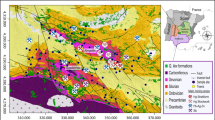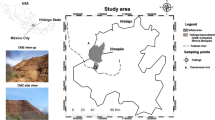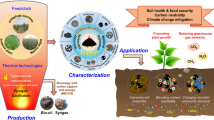Abstract
Metal(loid) soil pollution is a major environmental and health issue, requiring these areas to be remediated, for example through phytoremediation processes. In order to allow proper plant establishment and growth, amendments must be applied to highly contaminated and poorly fertile soils. Amendments are diverse, but many studies have shown the beneficial effects of biochar, manure and ochre, although studies on their combined use are scarce. Moreover, no studies have evaluated the effect of these combined amendments on endemic plant growth. Endemic plants growing on contaminated soils showed higher tolerance toward pollutants compared to plants coming from unpolluted areas. Therefore, the aim of the present study was to evaluate both the effect of amendments (single or combined) on the physicochemical properties of a former mining technosol, and the growth and metal(loid) accumulation ability of endemic Agrostis capillaris plants. This study revealed an improvement in the soil physicochemical properties following the application of amendments, with combined amendments showing better results than the application of just one. On top of this, Agrostis plants performed better on the amended technosols, especially the ones receiving manure, due to its high nutrient content. Finally, based on soil properties, plant growth and the metal(loid) accumulation profile, the use of biochar combined with manure seems to be the most appropriate treatment. Indeed, this treatment showed an improvement in both soil fertility and plant growth. Moreover, Agrostis plants grown in these conditions were among those showing higher root metal(loid) concentration associated with a lower translocation toward aerial parts.


Similar content being viewed by others
References
Abbas, T., Rizwan, M., Ali, S., Adrees, M., Mahmood, A., Rehman, M. Z., et al. (2018). Biochar application increased the growth and yield and reduced cadmium in drought stressed wheat grown in an aged contaminated soil. Ecotoxicology and Environmental Safety, 148, 825–833.
Abed, S. N., Almuktar, S. A., & Scholz, M. (2017). Treatment of contaminated greywater using pelletised mine water sludge. Journal of Environmental Management, 197, 10–23.
Ahmad, W., Najeeb, U. and Zia, M. H. (2015). Soil Contamination with Metals: Sources, Types and Implications.
Ali, H., Khan, E., & Sajad, M. (2013). Phytoremediation of heavy metals—Concepts and applications. Chemosphere, 91(7), 869–881.
Alvarenga, P., de Varennes, A., & Cunha-Queda, A. (2013). The Effect of Compost Treatments and A Plant Cover with Agrostis tenuis on the Immobilization/Mobilization of Trace Elements in a Mine-Contaminated Soil. International Journal of Phytoremediation, 16(2), 138–154.
Anawar, H., Akter, F., Solaiman, Z., & Strezov, V. (2015). Biochar: an Emerging Panacea for Remediation of Soil Contaminants from Mining. Industry and Sewage Wastes. Pedosphere, 25(5), 654–665.
Arienzo, M., Christen, E. W., Quayle, W., & Kumar, A. (2009). A review of the fate of potassium in the soil–plant system after land application of wastewaters. Journal of Hazardous Materials, 164(2–3), 415–422.
Austruy, A., Wanat, N., Moussard, C., Vernay, P., Joussein, E., Ledoigt, G., et al. (2013). Physiological impacts of soil pollution and arsenic uptake in three plant species: agrostis capillaris, Solanum nigrum and Vicia faba. Ecotoxicology and Environmental Safety, 90, 28–34.
Badri, D. V., & Vivanco, J. M. (2009). Regulation and function of root exudates. Plant, Cell and Environment, 32(6), 666–681.
Beesley, L., Moreno-Jiménez, E., & Gomez-Eyles, J. (2010). Effects of biochar and greenwaste compost amendments on mobility, bioavailability and toxicity of inorganic and organic contaminants in a multi-element polluted soil. Environmental Pollution, 158(6), 2282–2287.
Cao, X., Ma, L. Q., & Shiralipour, A. (2003). Effects of compost and phosphate amendments on arsenic mobility in soils and arsenic uptake by the hyperaccumulator. Pteris vittata L. Environmental Pollution, 126(2), 157–167.
Celik, I., Ortas, I., & Kilic, S. (2004). Effects of compost, mycorrhiza, manure and fertilizer on some physical properties of a Chromoxerert soil. Soil and Tillage Research, 78(1), 59–67.
Cha, J. S., Park, S. H., Jung, S. C., Ryu, C., Jeon, J. K., Shin, M. C., et al. (2016). Production and utilization of biochar: a review. Journal of Industrial and Engineering Chemistry, 40, 1–15.
Chen, D., Liu, X., Bian, R., Cheng, K., Zhang, X., Zheng, J., et al. (2018). Effects of biochar on availability and plant uptake of heavy metals–A meta-analysis. Journal of Environmental Management, 222, 76–85.
Cristaldi, A., Conti, G. O., Jho, E. H., Zuccarello, P., Grasso, A., Copat, C., et al. (2017). Phytoremediation of contaminated soils by heavy metals and PAHs. A brief review. Environmental Technology & Innovation, 8, 309–326.
Dahmani-Muller, H., Van Oort, F., Gelie, B., & Balabane, M. (2000). Strategies of heavy metal uptake by three plant species growing near a metal smelter. Environmental Pollution, 109(2), 231–238.
Development Core Team, R. (2009). R: a language and environment for statistical computing. Vienne, Austria: R foundation for statistical Computing.
Doi, M., Warren, G., & Hodson, M. E. (2005). A preliminary investigation into the use of ochre as a remedial amendment in arsenic-contaminated soils. Applied Geochemistry, 20(12), 2207–2216.
Doubková, P., & Sudová, R. (2016). Limited impact of arbuscular mycorrhizal fungi on clones of Agrostis capillaris with different heavy metal tolerance. Applied Soil Ecology, 99, 78–88.
Erickson, J. E., Cisar, J. L., Snyder, G. H., & Volin, J. C. (2005). Phosphorus and potassium leaching under contrasting residential landscape models established on a sandy soil. Crop Science, 45(2), 546–552.
Fitz, W., & Wenzel, W. (2002). Arsenic transformations in the soil–rhizosphere–plant system: fundamentals and potential application to phytoremediation. Journal of Biotechnology, 99(3), 259–278.
Fresno, T., Moreno-Jiménez, E., & Peñalosa, J. M. (2016). Assessing the combination of iron sulfate and organic materials as amendment for an arsenic and copper contaminated soil. A chemical and ecotoxicological approach. Chemosphere, 165, 539–546.
Gautam, M., & Agrawal, M. (2017). Phytoremediation of metals using vetiver (Chrysopogon zizanioides (L.) Roberty) grown under different levels of red mud in sludge amended soil. Journal of Geochemical Exploration, 182, 218–227.
Gray, C. W., Dunham, S. J., Dennis, P. G., Zhao, F. J., & McGrath, S. P. (2006). Field evaluation of in situ remediation of a heavy metal contaminated soil using lime and red-mud. Environmental Pollution, 142(3), 530–539.
Gunes, A., Pilbeam, D. J., & Inal, A. (2009). Effect of arsenic-phosphorus interaction on arsenic-induced oxidative stress in chickpea plants. Plant and Soil, 314(1–2), 211–220.
Hattab-Hambli, N., Motelica-Heino, M., & Mench, M. (2016). Aided phytoextraction of Cu, Pb, Zn, and As in copper-contaminated soils with tobacco and sunflower in crop rotation: Mobility and phytoavailability assessment. Chemosphere, 145, 543–550.
Huang, L. M., Yu, G. W., Zou, F. Z., Long, X. X., & Wu, Q. T. (2018). Shift of soil bacterial community and decrease of metals bioavailability after immobilization of a multi-metal contaminated acidic soil by inorganic-organic mixed amendments: A field study. Applied Soil Ecology, 130, 104–119.
Jarup, L. (2003). Hazards of heavy metal contamination. British Medical Bulletin, 68(1), 167–182.
Jiang, W., Hou, Q., Yang, Z., Zhong, C., Zheng, G., Yang, Z., et al. (2014). Evaluation of potential effects of soil available phosphorus on soil arsenic availability and paddy rice inorganic arsenic content. Environmental Pollution, 188, 159–165.
Khalid, S., Shahid, M., Niazi, N., Murtaza, B., Bibi, I. and Dumat, C. (2016). A comparison of technologies for remediation of heavy metal contaminated soils. Journal of Geochemical Exploration, 182, Part B, 247-268.
Kidd, P., Barceló, J., Bernal, M., Navari-Izzo, F., Poschenrieder, C., Shilev, S., et al. (2009). Trace element behaviour at the root–soil interface: Implications in phytoremediation. Environmental and Experimental Botany, 67(1), 243–259.
Kiran, Y. K., Barkat, A., Cui, X. Q., Feng, Y., Pan, F. S., Tang, L. and Yang, X. E. (2017). Cow manure and cow manure-derived biochar application as a soil amendment for reducing cadmium availability and accumulation by Brassica chinensis L. in acidic red soil. Journal of Integrative Agriculture, 16(3), 725-734.
Lebrun, M., Macri, C., Miard, F., Hattab-Hambli, N., Motelica-Heino, M., Morabito, D., et al. (2017). Effect of biochar amendments on As and Pb mobility and phytoavailability in contaminated mine technosols phytoremediated by Salix. Journal of Geochemical Exploration, 182, 149–156.
Lebrun, M., Miard, F., Nandillon, R., Hattab-Hambli, N., Scippa, G. S., Bourgerie, S., et al. (2018a). Eco-restoration of a mine technosol according to biochar particle size and dose application: study of soil physico-chemical properties and phytostabilization capacities of Salix viminalis. Journal of Soils and Sediments, 18(6), 2188–2202.
Lebrun, M., Miard, F., Nandillon, R., Léger, J. C., Hattab-Hambli, N., Scippa, G. S., et al. (2018b). Assisted phytostabilization of a multicontaminated mine technosol using biochar amendment: Early stage evaluation of biochar feedstock and particle size effects on As and Pb accumulation of two Salicaceae species (Salix viminalis and Populus euramericana). Chemosphere, 194, 316–326.
Lebrun, M., Miard, F., Nandillon, R., Scippa, G. S., Bourgerie, S., & Morabito, D. (2019). Biochar effect associated with compost and iron to promote Pb and As soil stabilization and Salix viminalis L. growth. Chemosphere, 222, 810–822.
Lebrun, M., Miard, F., Renouard, S., Nandillon, R., Scippa, G. S., Morabito, D., et al. (2018c). Effect of Fe-functionalized biochar on toxicity of a technosol contaminated by Pb and As: sorption and phytotoxicity tests. Environmental Science and Pollution Research, 25(33), 33678–33690.
Lee, S. H., Lee, J. S., Choi, Y. J., & Kim, J. G. (2009). In situ stabilization of cadmium-, lead-, and zinc-contaminated soil using various amendments. Chemosphere, 77(8), 1069–1075.
Liang, J., Yang, Z., Tang, L., Zeng, G., Yu, M., Li, X., et al. (2017). Changes in heavy metal mobility and availability from contaminated wetland soil remediated with combined biochar-compost. Chemosphere, 181, 281–288.
Lomaglio, T., Hattab-Hambli, N., Bret, A., Miard, F., Trupiano, D., Scippa, G. S., et al. (2017). Effect of biochar amendments on the mobility and (bio) availability of As, Sb and Pb in a contaminated mine technosol. Journal of Geochemical Exploration, 182, 138–148.
Mandal, B. K., & Suzuki, K. T. (2002). Arsenic round the world: a review. Talanta, 58(1), 201–235.
Marques, A. P., Oliveira, R. S., Rangel, A. O., & Castro, P. M. (2008). Application of manure and compost to contaminated soils and its effect on zinc accumulation by Solanum nigrum inoculated with arbuscular mycorrhizal fungi. Environmental Pollution, 151(3), 608–620.
Marseille, F., Tiffreau, C., Laboudigue, A., & Lecomte, P. (2000). Impact of vegetation on the mobility and bioavailability of trace elements in a dredged sediment deposit: a greenhouse study. Agronomie, 20(5), 547–556.
Materechera, S. A., & Mkhabela, T. S. (2002). The effectiveness of lime, chicken manure and leaf litter ash in ameliorating acidity in a soil previously under black wattle (Acacia mearnsii) plantation. Bioresource Technology, 85(1), 9–16.
Mokolobate, M., & Haynes, R. (2002). Comparative liming effect of four organic residues applied to an acid soil. Biology and Fertility of Soils, 35(2), 79–85.
Moreno-Jiménez, E., Fernández, J. M., Puschenreiter, M., Williams, P. N., & Plaza, C. (2016). Availability and transfer to grain of As, Cd, Cu, Ni, Pb and Zn in a barley agri-system: Impact of biochar, organic and mineral fertilizers. Agriculture, Ecosystems & Environment, 219, 171–178.
Mosaddeghi, M. R., Mahboubi, A. A., & Safadoust, A. (2009). Short-term effects of tillage and manure on some soil physical properties and maize root growth in a sandy loam soil in western Iran. Soil and tillage research, 104(1), 173–179.
Namgay, T., Singh, B. and Singh, B. (2010). Influence of biochar application to soil on the availability of As, Cd, Cu, Pb, and Zn to maize (Zea mays L.). Aust. J. Soil Res., 48(7), 638-647.
Nandillon, R., Lebrun, M., Miard, F., Gaillard, M., Sabatier, S., Morabito, D., & Bourgerie, S. (2019). Contrasted tolerance of Agrostis capillaris metallicolous and non-metallicolous ecotypes in the context of a mining technosol amended by biochar, compost and iron sulfate. Environmental geochemistry and health. https://doi.org/10.1007/s10653-019-00447-8.
Norini, M. P., Thouin, H., Miard, F., Battaglia-Brunet, F., Gautret, P., Guégan, R., et al. (2019). Mobility of Pb, Zn, Ba, As and Cd toward soil pore water and plants (willow and ryegrass) from a mine soil amended with biochar. J. Env. Manage., 232, 117–130.
Olimah, J. A., Shaw, L. J., & Hodson, M. E. (2015). Does ochre have the potential to be a remedial treatment for As-contaminated soils? Environmental Pollution, 206, 150–158.
Oustriere, N., Marchand, L., Galland, W., Gabbon, L., Lottier, N., Motelica, M., et al. (2016). Influence of biochars, compost and iron grit, alone and in combination, on copper solubility and phytotoxicity in a Cu-contaminated soil from a wood preservation site. Science of the Total Environment, 566–567, 816–825.
Pueyo, M., López-Sánchez, J., & Rauret, G. (2004). Assessment of CaCl2, NaNO3 and NH4NO3 extraction procedures for the study of Cd, Cu, Pb and Zn extractability in contaminated soils. Analytica Chimica Acta, 504(2), 217–226.
Rinklebe, J., Shaheen, S. M., & Frohne, T. (2016). Amendment of biochar reduces the release of toxic elements under dynamic redox conditions in a contaminated floodplain soil. Chemosphere, 142, 41–47.
Rodríguez-Seijo, A., Lago-Vila, M., Andrade, M. L., & Vega, F. A. (2016). Pb pollution in soils from a trap shooting range and the phytoremediation ability of Agrostis capillaris L. Environmental Science and Pollution Research, 23(2), 1312–1323.
Rodríguez-Vila, A., Forján, R., Guedes, R. S., & Covelo, E. F. (2017). Nutrient phytoavailability in a mine soil amended with technosol and biochar and vegetated with Brassica juncea. Journal of Soils and Sediments, 17(6), 1653–1661.
Sharma, R. K., & Agrawal, M. (2005). Biological effects of heavy metals: an overview. Journal of Environmental Biology, 26(2), 301–313.
Su, C., Jiang, L., & Zhang, W. (2014). A review on heavy metal contamination in the soil worldwide: situation, impact and remediation techniques. Environmental Skeptics and Critics, 3(2), 24–38.
Sudová, R., Doubková, P., & Vosátka, M. (2008). Mycorrhizal association of Agrostis capillaris and Glomus intraradices under heavy metal stress: combination of plant clones and fungal isolates from contaminated and uncontaminated substrates. Applied Soil Ecology, 40(1), 19–29.
Tang, X., Li, X., Liu, X., Hashmi, M., Xu, J., & Brookes, P. (2015). Effects of inorganic and organic amendments on the uptake of lead and trace elements by Brassica chinensis grown in an acidic red soil. Chemosphere, 119, 177–183.
Thouin, H., Norini, M. P., Le Forestier, L., Gautret, P., Motelica-Heino, M., Breeze, D., et al. (2019). Microcosm-scale biogeochemical stabilization of Pb, As, Ba and Zn in mine tailings amended with manure and ochre. Applied Geochemistry, 111, 104438.
Van Poucke, R., Ainsworth, J., Maeseele, M., Ok, Y. S., Meers, E., & Tack, F. M. G. (2018). Chemical stabilization of Cd-contaminated soil using biochar. Applied Geochemistry, 88, 122–130.
Walker, D. J., Clemente, R. and Bernal, M. P. (2004). Contrasting effects of manure and compost on soil pH, heavy metal availability and growth of Chenopodium album L. in a soil contaminated by pyritic mine waste. Chemosphere, 57(3), 215-224.
Whalen, J. K., Chang, C., Clayton, G. W., & Carefoot, J. P. (2000). Cattle manure amendments can increase the pH of acid soils. Soil Science Society of America Journal, 64(3), 962–966.
Wong, M. H. (2003). Ecological restoration of mine degraded soils, with emphasis on metal contaminated soils. Chemosphere, 50(6), 775–780.
Funding
This research work was performed within the framework of the Phytoselect Project funded by the Région Centre - Val de Loire (Contract No. 2016-00108485).
Author information
Authors and Affiliations
Corresponding author
Additional information
Publisher's Note
Springer Nature remains neutral with regard to jurisdictional claims in published maps and institutional affiliations.
Electronic supplementary material
Below is the link to the electronic supplementary material.
Rights and permissions
About this article
Cite this article
Lebrun, M., Nandillon, R., Miard, F. et al. Effects of biochar, ochre and manure amendments associated with a metallicolous ecotype of Agrostis capillaris on As and Pb stabilization of a former mine technosol. Environ Geochem Health 43, 1491–1505 (2021). https://doi.org/10.1007/s10653-020-00592-5
Received:
Accepted:
Published:
Issue Date:
DOI: https://doi.org/10.1007/s10653-020-00592-5




